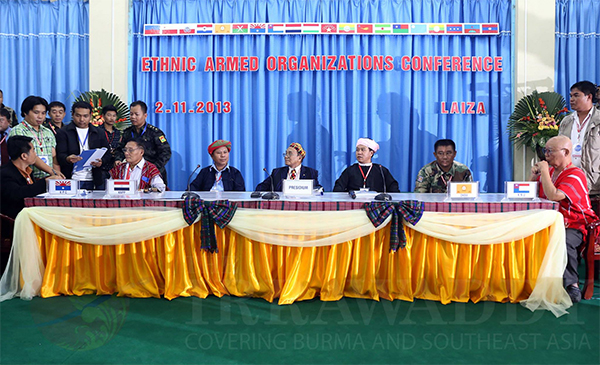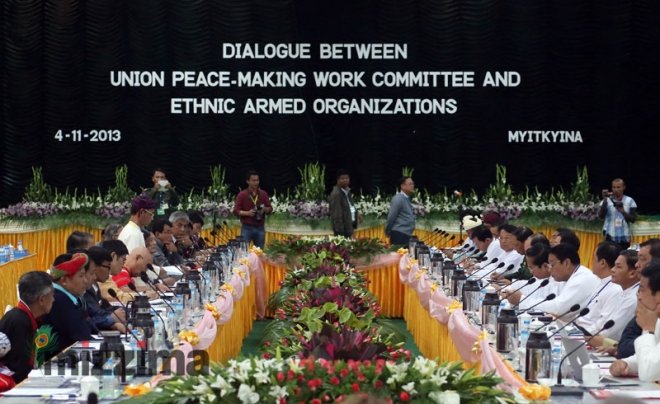The first and perhaps the only lesson I received after I was appointed as the foreign relations officer for the Shan United Revolutionary Army in 1980 came from a Thai visitor to the SURA headquarters. It was a succinct one which I remember up to this day:
A woman who says ‘Yes’ is not a lady
A man who says ‘No’ is not a diplomat
When a lady says ‘Maybe’ she means ‘Yes’
When a diplomat says ‘Maybe’, he means ‘No’
And that was exactly what happened at Myitkyina, where the Nationwide Ceasefire Coordination Team (NCCT), formed by the Ethnic Armed Organizations (EAO) Conference in Laiza, 30 October-2 November 2013, met the government’s Union Peacemaking Work Committee (UPWC), 4-5 November.

The government side, after saying the NCCT’s 11 point framework for political dialogue topics were okay “in principle” except for toning down some of the words like “Formation of a Union Armed Forces” to “Union Armed Forces issue”, presented it with copies of the Nationwide Ceasefire Agreement (NCA), the latest draft reportedly drawn up jointly by the government, parliament and the armed forces.
To the ethnic representatives who had received the second NCA draft (drawn by the government) only just before the Laiza conference, where some of whom had thought it was worth considering, the newly revised draft came as a big shock.
It minced no words telling the EAOs they must “renounce the armed struggle and” that “only previous signed agreements that do not violate existing laws would be endorsed.” And more of them in the same vein.
Even some representatives from Karen National Union (KNU), Karenni National Progressive Party (KNPP), Chin National Front (CNF) and the Restoration Council of Shan State (RCSS) who had earlier supported the idea of the signing of the NCA were speechless. “If they are set on this,” said one after the meeting on the first day ended, “there is nothing more for us but to go back to war.”

Fortunately, cooler heads saved the day for both sides, whose two-day meeting was being observed by the UN’s Vijay Nambiar and China’s Wang Yinfan.
The NCCT proposed another meeting to resolve the matter, which was promptly accepted by the UPWC. “Apart from secession and infringement of national sovereignty, everything else is on the table,” U Aung Min, Vice Chairman of the UPWC, said as the meeting adjourned for the drafting of a joint statement.
Naturally what has been taking place on both sides since 5 November until yet-to-be-fixed date in December when the two are scheduled to meet again in Karen State’s Pa-an is the compilation of feedback among each side’s camp:
On the government side, whether it should accept the EAO’s proposal that it resets the sequence of things from signing of Nationwide Ceasefire, agreement on Framework for political dialogue and holding of Political Dialogue, to Framework, Nationwide Ceasefire and Political Dialogue
On the EAOs side, it will clearly be whether to suggest amendments to the government’s proposal or present a new one (Sounds very much like the ongoing reaction to the military-drawn 2008 constitution, doesn’t it?)
Some have asked me what I think the likely scenario at Pa-an will be? I said I didn’t have a crystal ball, but that I hoped the talks will continue whatever the results are. The “War of Saliva” is to be preferred to War of Bullets, isn’t it so?
I hereby end this rambling appropriately, I hope, with a song from the late Bobby Darin:
“Now no doubt some folks enjoy doing battle
Like presidents, prime ministers and kings
So let’s all build them shelves
Where they can fight among themselves
Leave the people be who love to sing
Come and sing a simple song of freedom
Sing it like you’ve never sung before
Let it fill the air
Tell the people everywhere
We, the people here, don’t want a war”


